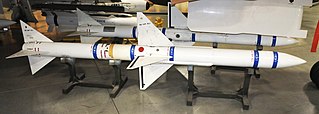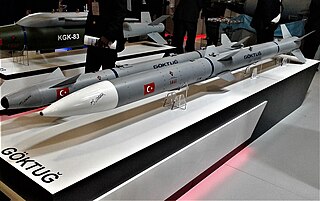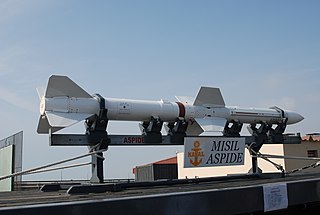
The AIM-7 Sparrow is an American medium-range semi-active radar homing air-to-air missile operated by the United States Air Force, United States Navy, United States Marine Corps, and various other air forces and navies. Sparrow and its derivatives were the West's principal beyond visual range (BVR) air-to-air missile from the late 1950s until the 1990s. It remains in service, although it is being phased out in aviation applications in favor of the more advanced AIM-120 AMRAAM.

The AIM-120 Advanced Medium-Range Air-to-Air Missile(AMRAAM) ( AM-ram) is an American beyond-visual-range air-to-air missile capable of all-weather day-and-night operations. It uses active transmit-receive radar guidance instead of semi-active receive-only radar guidance. When an AMRAAM missile is launched, NATO pilots use the brevity code "Fox Three".

An air-to-air missile (AAM) is a missile fired from an aircraft for the purpose of destroying another aircraft. AAMs are typically powered by one or more rocket motors, usually solid fueled but sometimes liquid fueled. Ramjet engines, as used on the Meteor, are emerging as propulsion that will enable future medium- to long-range missiles to maintain higher average speed across their engagement envelope.

An anti-radiation missile (ARM) is a missile designed to detect and home in on an enemy radio emission source. Typically, these are designed for use against an enemy radar, although jammers and even radios used for communications can also be targeted in this manner.

The Novator KS-172 was a Russian air-to-air missile project designed as an "AWACS killer" at ranges up to 400 km. The missile had various names during its history, including K-100, Izdeliye 172, AAM-L (RVV-L), KS–172, KS-1, 172S-1 and R-172. The airframe appears to have been derived from the 9K37 Buk surface-to-air missile (SAM) but development stalled in the mid-1990s for lack of funds. It appears to have restarted in 2004 after a deal with India, who wants to produce the missile in India for their Su-30MKI fighters. Development has ceased and the project is closed.
A beyond-visual-range missile is an air-to-air missile that is capable of engaging at ranges around 40 km (22 nmi) or beyond. This range has been achieved using dual pulse rocket motors or booster rocket motor and ramjet sustainer motor. Medium-range, long-range, and very-long-range air-to-air missiles fall under the category of beyond-visual-range missiles. Older BVR missiles generally used the semi-active radar homing, and modern BVR missiles use the active radar homing guidance.

The Sky Sword II, Tien Chien II, or TC-2 is a Taiwanese beyond-visual-range air-to-air missile. It has an inertial navigation system, a data-link for mid-course guidance and active radar homing for terminal guidance, beyond visual range. It also has ECCM capability and can engage multiple targets. According to Su Tzu-yun, chief executive officer at the Center for Advanced Technology at Tamkang University, they are a cost-effective design which can perform a key role in Taiwan's defense strategy, and substantially offset China's air superiority. Some details of its design were revealed for the first time at the Paris Air Show in 2015. The pulse doppler radar seeker reportedly has a detection range of 9.3 km (5.8 mi).

The PL-12 is an active radar-guided beyond-visual-range air-to-air missile developed by the People's Republic of China. It is considered comparable to the US AIM-120 AMRAAM and the Russian R-77.

Aspide is an Italian medium range air-to-air and surface-to-air missile produced by Selenia. It is provided with semi-active radar homing seeker. It is very similar to the American AIM-7 Sparrow, using the same airframe, but uses an inverse monopulse seeker that is far more accurate and much less susceptible to ECM than the original conical scanning version.

The National Engineering & Scientific Commission (NESCOM) is a Pakistani government-funded defence contractor that develops, designs and sells defense hardware, including missile and weapon systems. It was funded and formed by the Government of Pakistan to develop its domestic production of weapon system.

The HQ-9 is a long-range semi-active radar homing (SARH) surface-to-air missile (SAM) developed by the People's Republic of China. The naval variant is the HHQ-9.

The KLJ-7, also referred to as the Type 1478, is an X band airborne fire-control radar (FCR) developed by Nanjing Research Institute of Electronic Technology (NRIET), also known as the China Electronics Technology Company's (CETC's) No. 14 Research Institute. In December 2010, Pakistan Air Force's Air Chief Marshal Rao Qamar Suleman announced that KLJ-7 radar will be built at Pakistan Aeronautical Complex (PAC), in Kamra, north of Islamabad.

The AIM-9 Sidewinder is a short-range air-to-air missile. Entering service with the United States Navy in 1956 and the Air Force in 1964, the AIM-9 is one of the oldest, cheapest, and most successful air-to-air missiles. Its latest variants remain standard equipment in most Western-aligned air forces. The Soviet K-13, a reverse-engineered copy of the AIM-9B, was also widely adopted.

The PL-10, formerly known as PL-ASR, is a short-range, infrared-homing / active radar homing air-to-air missile (AAM) developed by the People's Republic of China. It was designed by Dr. Liang Xiaogeng (梁晓庚) at the Luoyang Electro Optical Center, which is also known as the Institute 612 and was renamed in 2002 as the China Air-to-Air Guided Missile Research Institute (中国空空导弹研究院). Development of the missile commenced in 2004 for use on stealth fighters such as the J-20 and J-35.

The PL-15 is an active radar-guided long-range air-to-air missile developed by the People's Republic of China.
The AIM-260 Joint Advanced Tactical Missile (JATM) is an American beyond-visual-range air-to-air missile (BVRAAM) under development by Lockheed Martin. Designed to address advanced threats, the missile is expected to replace or supplement the AIM-120 AMRAAM currently in US service. The United States Department of Defense (DoD) considers the AIM-260A JATM program to be the number one air-delivered weapon priority for both the U.S. Air Force (USAF) and the Navy (USN); and its acquisition out-prioritizes other weapon system improvements and modernization efforts on any fielded aircraft. As of May 2024, the House Armed Services Committee was investigating whether more late-variant AMRAAMs would be required in light of the AIM-260 JATM not having entered full-scale production, though the USAF insisted in May 2023 that AIM-260 development and production was on-schedule.

The Shahpar-ll is an unmanned combat aerial vehicle (UCAV) built by Global Industrial Defence Solutions of Pakistan. It is currently in production following the completion of a test and qualification phase.

The GOKDENIZ complex along with Aselsan ATOM 35mm airburst ammunition is an all-weather-capable Turkish 35 mm dual barrel close-in weapon system (CIWS) developed by Aselsan. It is a CIWS variant of KORKUT Self-propelled anti-aircraft gun.














